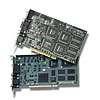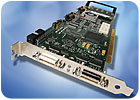
It has evolved to become a fast and reliable tool for quality control inspection. As initiatives such as Six Sigma and TQM push quality standards to the highest levels, machine vision can aid manufacturing organizations in reaching their quality goals.
Machine vision is a specific application of computer vision that enables cameras and computers to replace humans in evaluation and inspection tasks that are precise, repetitive or high speed. Today, more than ever, machine vision is being used to ensure quality in manufacturing everything from diapers to the most advanced computer chips.
How It Works
A machine vision system acquires images of an object, and then uses computers to process, analyze and measure various characteristics of that object so decisions can be made. These decisions may involve characteristics that cannot be seen by the human eye, or analyzing image data for measurement purposes. Qualifying parts as "good" or "bad" based on their shape or size is the cornerstone of quality inspection systems. In addition, products built in stages can benefit from inspection throughout the process. Because each production stage has a cost per unit associated with it, eliminating bad parts early in the process can save money and improve efficiency.To maximize the effectiveness of machine vision, consider various ways to help the system to see possible problems, for example, by mechanically positioning the part under inspection, and using lighting and optics that clearly show the defects.
Almost any industry can benefit from machine vision systems: semiconductor, automotive, glass, paper, plastics, food and beverage packaging, medical and pharmaceutical. Specific systems can be customized to a particular industry, or company's needs, but the basics are the same.

Benefits of Machine Vision
Vision system suppliers have always designed solutions to help manufacturers address the ever-pressing need for precise inspection. Just as human inspectors working on assembly lines visually inspect parts to judge the quality of workmanship, machine vision systems use cameras, lighting, image acquisition hardware and processing software to perform similar inspections.Machine vision is an economical way to conduct quality inspections. In many cases, a machine vision or computer vision system can do things more quickly and accurately than humans and at a lower cost. Calculate safety into the equation as well-many times, robots can perform tasks in unsafe environments or can go to places where humans cannot.
Prepackaged machine vision solutions, typically using one to four off-the-shelf cameras, can provide real-time image processing, as well as control hardware on the production floor. This is an ideal solution for the factory floor technician who needs basic machine-vision inspection. This type of inspection system can be up and running in a short time for $10,000 or less. The result is improved quality of products and reduced labor time.
Applications
One machine-vision application is inspecting printed circuit boards to make certain that the conductors are the correct size, and that there are no short or open circuits. This evaluation requires many fast measurements on many circuit boards and is therefore difficult for a human inspector to do reliably.In the machine parts industry, one company used machine-vision inspection to improve the quality and throughput of a unique and proprietary manufacturing process used to produce seatbelt retractor gear for the automotive industry. With the implementation of a machine vision system, more than 35 million parts have been inspected without a single lot rejected by the customer.
As every facet of a product is examined for optimum quality, and the costs of highly effective machine vision systems decrease, many industries are beginning to adopt universal quality inspection with machine vision systems.